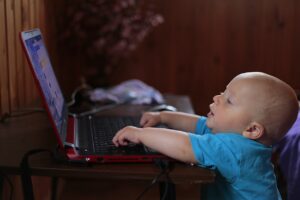
Child Online Safety in the Midst of Covid-19
by Mamoqenelo Morolong
Social distancing and other measures put in place to curb the COVID-19 spread have pushed communities to adopt the new ways of living. School closures and strict confinement measures mean more and more families are relying on technology and digital solutions to keep children learning, entertained and connected to the outside world, but not all children have the necessary knowledge, skills and resources to keep themselves safe online.
We cannot deny the fact that COVID-19 has forced all of us to stay with our families, schools have closed but education has to continue anyway. Thus research show that children now spent more time online than in normal times[1].
With 1.5 billion students out of school world-wide[2]; schools and countries have resorted to the use of technology to deliver lessons to students. Most high schools in developed countries are using smart virtual learning platform such as Moodle and other interactive learning tools while in the developing countries, most high schools do not have adequate and necessary infrastructure as compared to developed countries.
The use of technology differs by education levels, meaning that most of the Higher learning institutions with infrastructure can fully adopt on-learning/ e-learning. That is evidenced by most universities within the African continent. However, the challenge is still with the primary and secondary schools. It is a sad truth that in African countries public schools do not have infrastructure for online learning and the standard of living for rural populations might not enable the adoption thereof.

However, in the plan of delivering education to their learners, primary and secondary school teachers have tried to use social medial platforms such as WhatsApp as the means of delivering content to students. With that said it means children are now online more than they used to be. Even those that had not been online before are forced to adopt to the new ways of virtual electronic learning, thus the number of children online has escalated since the COVID-19 outbreak.
Regardless of the positive impact of continuous learning through digital technologies and the Internet, a myriad of negative impacts of online existence to children has increased. United Nations showed that online predators put millions of children at risk during COVID-19 pandemic lockdown, children sextortion and cyber bullying being the examples of such risks.
It also sad to mention that parents and care takers are not aware of the content their children are exposed to. They also do not have the correct knowledge and experience on how to monitor nor suggest online safety tools for their children. Thus the Child Online Protection Team at Namibia University of Science and Technology are here to offer online safety tips.
 Tips for children:
Tips for children:
- Checking privacy settings: it is advisable that you use strong passwords on the devices.
- Turning off your location: making sure locations cannot be identified
- Blocking intrusive people: block anyone that makes you feel uncomfortable
- Trusted help: Knowing where you can seek help
Tips for parents and care takers
- Password safety: since most parents claim to forget their password while trying to tighten security on children’s devices they can then use tools like keepassx, Last Pass for managing password
- Communication: Speak to your children about online safety. Most of the young people especially teenagers have reported that they do not feel comfortable with speaking about their negative online encounters with their parents, this calls that parents establish enough time to talk to their children about online existence.
- Become familiar with online safety tools: you can set up parental control and use web browsers such as Duck Duck Go. As parents you can also use child control parenting apps available of Google play store. They can also make use of free ad blockers such as Ublock for blocking Ads on Google chrome or fire fox browsers and Virtual Private Network (VPN) such as Psiphon[3].
- Understand the risks that their children may face online: familiarise yourself with the risk that your children are exposed to.
- Be alert: you should be alert to signs of distress linked with online activity and know where to seek help.
- Avoid giving screens to children under three years of age. Increased screen time for children younger than three years is associated with negative health outcomes, including increased Body Mass Index (BMI), reduced cognitive and language development as well as reduced academic success[4].
- Supervise online time: Avoid letting children under the age of six play video games alone, they may be exposed to content not suited for them.
- Be careful and aware of the risks of adults trying to contact your child online: many children under 13 are unaware of the potential risks of social networking sites find more information here Better Internet for Kids – New awareness campaign on the use of screens in the family.
It is very crucial that in this trying time we stay safe and protect our online personas as well as those under our custody.
[1] https://www.unicef.org/laos/stories/keeping-children-safe-online-during-covid-19-pandemic.
[2] https://www.unicef.org/coronavirus/read-the-world
[3] https://www.psiphon3.com/en/download.html
[4] https://www.ncbi.nlm.nih.gov/pmc/articles/PMC3844496/
